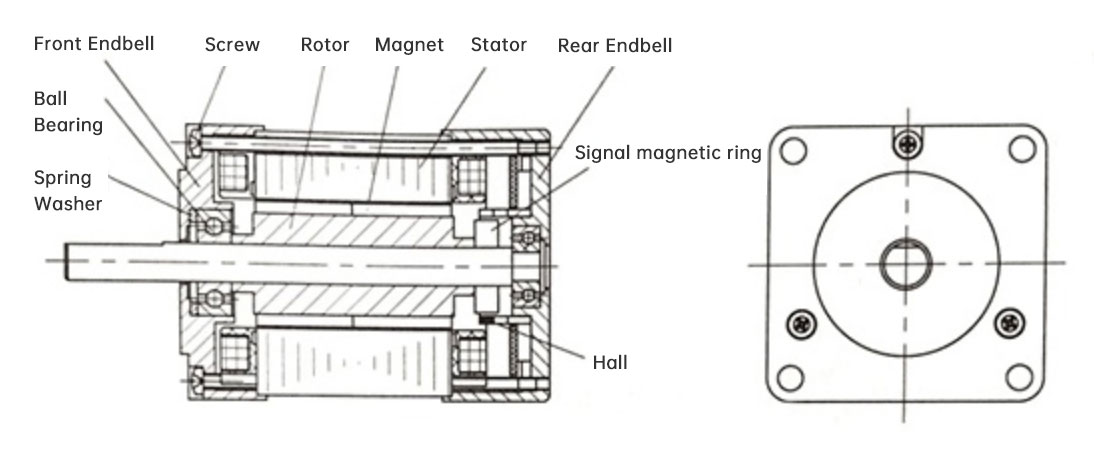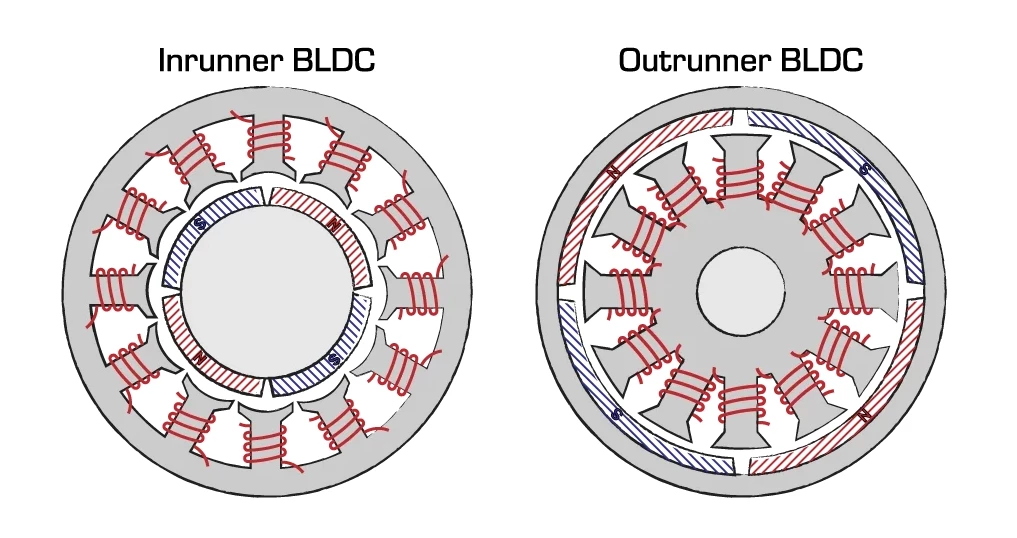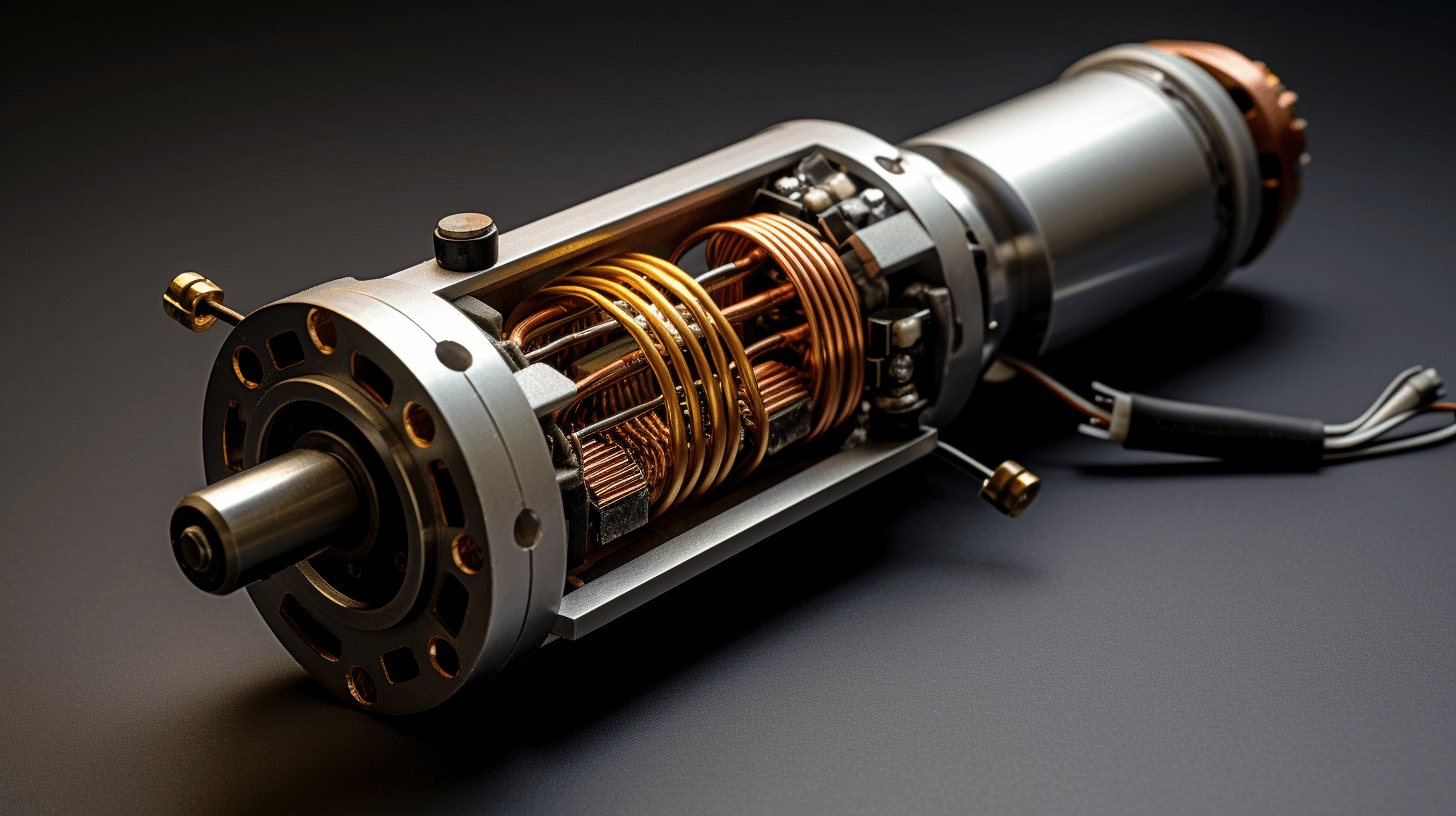Electric motors have revolutionized modern industries with efficient solutions. This article compares two popular types—Brushless DC (BLDC) and Coreless DC motors—focusing on their design, operation, efficiency, durability, and applications to help choose the right one.
Motor Design and Structure

Brushless DC Motor (BLDC): As the name implies, a brushless DC motor functions without brushes, and consists of two key components: a permanent magnet rotor and a stator with windings.
BLDC motors employ electronic commutation instead of brushes and a commutator to control the direction of current in the windings. The electromagnetic interaction between the rotor’s magnetic field and the stator windings drives the rotor, which is made up of permanent magnets.

BLDC motors are divided into two main categories:
- Inrunner Brushless DC motor: The rotor is inside the stator, often used for applications requiring high-speed operations.
- Outrunner Brushless DC motor: Higher torque is available at lower speeds since the rotor is located outside the stator.

Coreless DC Motor: A coreless DC motor has an iron core-free rotor thanks to its innovative construction. Instead, it uses a cylindrical winding structure supported by a thin-walled structure or coil made from high-conductivity materials.
Without an iron core, the rotor’s weight and inertia are much reduced, allowing for quicker acceleration and better dynamic response. Coreless motors typically use brushes for commutation but have high efficiency due to their low rotor mass and reduced inductance.
Key takeaway:
- BLDC motors have a more conventional structure with electronic commutation, offering durability and versatility.
- Coreless motors use a lighter rotor without an iron core, which results in faster response times and lower inertia.
Operation and Working Principles
Brushless DC Motor: BLDC motors are controlled through electronic controllers that regulate the switching of the current in the stator windings to maintain rotation. Sensors, such as Hall effect sensors, detect the rotor’s position and guide the electronic controller in switching the current to the correct winding. This eliminates the mechanical wear and maintenance requirements associated with brushes, making BLDC motors more suitable for high-speed and long-term operation.
Coreless DC Motor: On the other hand, coreless BLDC motors rely on mechanical brushes to perform commutation. The rotor, which is made out of a lightweight coil, revolves within the stator’s permanent magnet-generated magnetic field. The absence of an iron core reduces the torque ripple and cogging effects, resulting in smoother and more precise motion. Coreless DC motors excel in applications requiring quick accelerations and precision control at low torque.
Key takeaway:
- BLDC motors rely on electronic commutation, allowing for higher speeds and lower maintenance.
- Coreless DC motors offer superior smoothness and responsiveness due to their low inertia but may require more frequent maintenance due to brushes.
Effectiveness and Power Output
Brushless DC Motor: BLDC motors, which usually operate at 85% to 90% efficiency, are renowned for their great efficiency. The absence of brushes reduces mechanical friction losses, and electronic commutation ensures that the motor operates optimally at various speeds. When high power output and continuous operation are required, BLDC motors are the best choice.
In terms of power density, BLDC motors generally have a higher power-to-weight ratio compared to brushed motors, and they can handle higher torque loads without sacrificing efficiency. The precise control over the commutation and the cooling provided by efficient designs also contribute to the high efficiency of BLDC motors.
Coreless DC Motor: Coreless DC motors are incredibly efficient when operating under low to moderate power conditions. Their lightweight rotor reduces losses associated with starting and stopping, and the absence of an iron core mitigates eddy current losses. This makes coreless motors highly efficient in short-duration or intermittent duty cycles, where quick response times are critical.
However, the efficiency of coreless DC motors at higher power outputs may not match that of BLDC motors, as the mechanical friction from brushes increases over time, particularly in long-duration applications.
Key takeaway:
- BLDC motors are generally more efficient in high-torque and long-duration applications due to electronic commutation.
- Coreless DC motors are more efficient in low-power, high-precision applications but may lose efficiency under continuous heavy loads.
Advantages and Disadvantages
BLDC Motor
| Advantage | Disadvantage |
| High Efficiency: Minimal losses due to the absence of brushes. | Cost: BLDC motors are typically more expensive than coreless or brushed motors due to the need for electronic controllers. |
| Durability: Long lifespan with minimal maintenance. | |
| High Torque at Low Speeds: Ideal for applications requiring precise control. | |
| Low Noise Operation: Suited for noise-sensitive environments. | Complexity: The electronic commutation system adds complexity to the motor design. |
| Heat Dissipation: Efficiently manages heat buildup during long operations. |
Coreless DC Motor
| Advantage | Disadvantage |
| Lightweight Design: Excellent power-to-weight ratio due to the absence of an iron core. | Brush Wear: The presence of brushes requires regular maintenance and replacement. |
| Fast Acceleration: Low rotor inertia allows for rapid speed changes. | Heat Generation: Although less than traditional motors, brushes still generate friction, leading to heat buildup. |
| Compact Size: Suitable for miniature applications where space is limited. | Lower Torque at Low Speeds: Coreless motors may struggle to provide high torque at low speeds compared to BLDC motors. |
| High Precision: Ideal for precision control in sensitive applications. |
Durability and Maintenance
Brushless DC Motor: One of the main advantages of BLDC motors is their long lifespan and low maintenance. Since there are no brushes or commutators to wear out, the only significant wear comes from the bearings, which can last a long time with proper care. The electronic commutation system eliminates the need for frequent maintenance, making BLDC motors the preferred choice for industrial automation, robotics, and aerospace applications where downtime must be minimized.
Coreless DC Motor: Coreless DC motors, while highly efficient and precise, are subject to wear due to the mechanical brushes used in commutation. Over time, the brushes and commutator can degrade, leading to increased maintenance and potential motor failure. Additionally, since coreless motors rely on their lightweight rotor design, they can be more prone to thermal issues when operated continuously at high power, as there is less mass to absorb heat.
Key takeaway:
- BLDC motors offer higher durability and lower maintenance requirements, making them suitable for demanding, continuous-use applications.
- Coreless motors may require more frequent maintenance due to the wear of brushes, making them ideal for applications where motor usage is intermittent.
Applications
Brushless DC Motor: Because of its adaptability, high power density, and extended lifespan, BLDC motors are utilized in a variety of applications. Some common applications include:
- Electric vehicles (EVs): High efficiency and durability make them ideal for long-distance travel.
- Drones and UAVs: Lightweight, high-torque, and reliable operation at various speeds.
- Medical devices: High precision and smooth operation, especially in applications like ventilators and robotic surgery.
- Industrial automation: BLDC motors are widely used in factory equipment, robotics, and automation systems due to their low maintenance requirements and high performance.
Coreless DC Motor: Coreless motors are typically found in applications where low inertia, fast response, and precise control are required. These include:
- High-end robotics: Precision control and low torque ripple make them perfect for surgical robots and precision instruments.
- Small electric tools: The lightweight design of coreless motors allows for high-speed and responsive operation in devices like dental drills and miniature tools.
- Aerospace applications: Coreless motors are used in satellite equipment and control systems due to their low weight and ability to perform in high-vibration environments.
Key takeaway:
- BLDC motors are ideal for applications requiring continuous operation, high power, and efficiency, such as EVs, drones, and industrial automation.
- Coreless DC motors excel in applications needing quick response, low inertia, and precision, such as medical devices and high-end robotics.
Cost Consideration
Brushless DC Motor: Because permanent magnets and intricate electronic controllers are required, BLDC motors are usually more expensive than brushed motors. However, the long lifespan and lower maintenance costs often justify the initial investment, especially for applications that require high reliability and continuous operation.
Coreless DC Motor: Coreless motors tend to be more expensive than conventional brushed motors, primarily due to the sophisticated design and materials used in the rotor construction. The lightweight design and precision control come at a higher cost, making coreless motors more suitable for applications where performance is prioritized over cost savings.
Key takeaway:
- Although BLDC motors require more upkeep and have a longer lifespan, they are more cost-effective in the long run.
- Coreless DC motors are more expensive than conventional motors and are ideal for high-performance, low-inertia applications where precision is essential.
Which Motor is Right for You?
Choosing between a Brushless DC motor and a Coreless DC motor depends on the specific requirements of your application.
- If your application demands high power, long continuous operation, and low maintenance, the BLDC motor is the superior choice. It’s best suited for industries such as electric vehicles, drones, and industrial automation, where efficiency and durability are critical.
- On the other hand, if your focus is on precision, lightweight operation, and quick dynamic response, the Coreless DC motor will outperform others. Because of their low inertia and reactivity, these motors are frequently utilized in aerospace, medical, and high-end robotic applications.
With knowledge of the benefits and drawbacks of every motor, you may choose the one that best suits your demands in terms of cost and performance.
